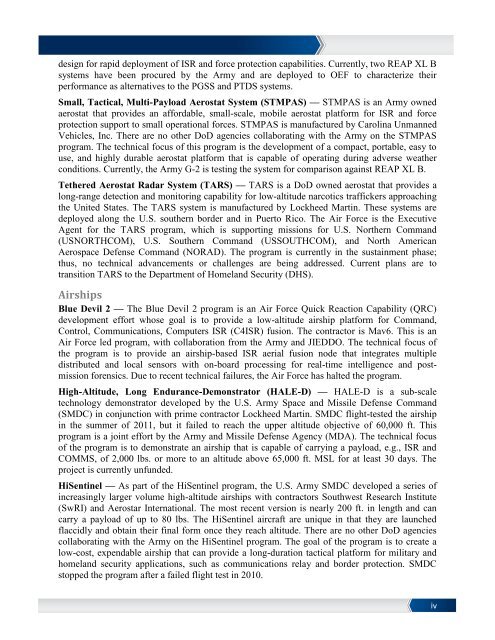lighter-than-air vehicles - Defense Innovation Marketplace
lighter-than-air vehicles - Defense Innovation Marketplace
lighter-than-air vehicles - Defense Innovation Marketplace
Create successful ePaper yourself
Turn your PDF publications into a flip-book with our unique Google optimized e-Paper software.
design for rapid deployment of ISR and force protection capabilities. Currently, two REAP XL Bsystems have been procured by the Army and are deployed to OEF to characterize theirperformance as alternatives to the PGSS and PTDS systems.Small, Tactical, Multi-Payload Aerostat System (STMPAS) — STMPAS is an Army ownedaerostat that provides an affordable, small-scale, mobile aerostat platform for ISR and forceprotection support to small operational forces. STMPAS is manufactured by Carolina UnmannedVehicles, Inc. There are no other DoD agencies collaborating with the Army on the STMPASprogram. The technical focus of this program is the development of a compact, portable, easy touse, and highly durable aerostat platform that is capable of operating during adverse weatherconditions. Currently, the Army G-2 is testing the system for comparison against REAP XL B.Tethered Aerostat Radar System (TARS) — TARS is a DoD owned aerostat that provides along-range detection and monitoring capability for low-altitude narcotics traffickers approachingthe United States. The TARS system is manufactured by Lockheed Martin. These systems aredeployed along the U.S. southern border and in Puerto Rico. The Air Force is the ExecutiveAgent for the TARS program, which is supporting missions for U.S. Northern Command(USNORTHCOM), U.S. Southern Command (USSOUTHCOM), and North AmericanAerospace <strong>Defense</strong> Command (NORAD). The program is currently in the sustainment phase;thus, no technical advancements or challenges are being addressed. Current plans are totransition TARS to the Department of Homeland Security (DHS).AirshipsBlue Devil 2 — The Blue Devil 2 program is an Air Force Quick Reaction Capability (QRC)development effort whose goal is to provide a low-altitude <strong>air</strong>ship platform for Command,Control, Communications, Computers ISR (C4ISR) fusion. The contractor is Mav6. This is anAir Force led program, with collaboration from the Army and JIEDDO. The technical focus ofthe program is to provide an <strong>air</strong>ship-based ISR aerial fusion node that integrates multipledistributed and local sensors with on-board processing for real-time intelligence and postmissionforensics. Due to recent technical failures, the Air Force has halted the program.High-Altitude, Long Endurance-Demonstrator (HALE-D) — HALE-D is a sub-scaletechnology demonstrator developed by the U.S. Army Space and Missile <strong>Defense</strong> Command(SMDC) in conjunction with prime contractor Lockheed Martin. SMDC flight-tested the <strong>air</strong>shipin the summer of 2011, but it failed to reach the upper altitude objective of 60,000 ft. Thisprogram is a joint effort by the Army and Missile <strong>Defense</strong> Agency (MDA). The technical focusof the program is to demonstrate an <strong>air</strong>ship that is capable of carrying a payload, e.g., ISR andCOMMS, of 2,000 lbs. or more to an altitude above 65,000 ft. MSL for at least 30 days. Theproject is currently unfunded.HiSentinel — As part of the HiSentinel program, the U.S. Army SMDC developed a series ofincreasingly larger volume high-altitude <strong>air</strong>ships with contractors Southwest Research Institute(SwRI) and Aerostar International. The most recent version is nearly 200 ft. in length and cancarry a payload of up to 80 lbs. The HiSentinel <strong>air</strong>craft are unique in that they are launchedflaccidly and obtain their final form once they reach altitude. There are no other DoD agenciescollaborating with the Army on the HiSentinel program. The goal of the program is to create alow-cost, expendable <strong>air</strong>ship that can provide a long-duration tactical platform for military andhomeland security applications, such as communications relay and border protection. SMDCstopped the program after a failed flight test in 2010.iv

















